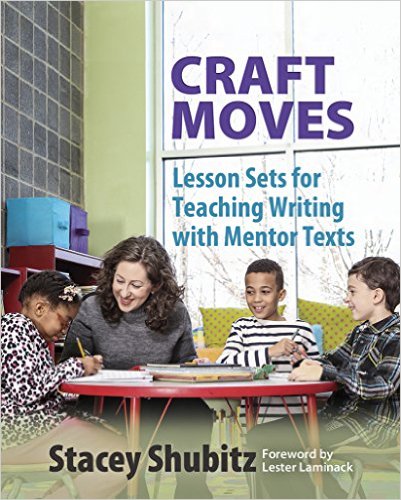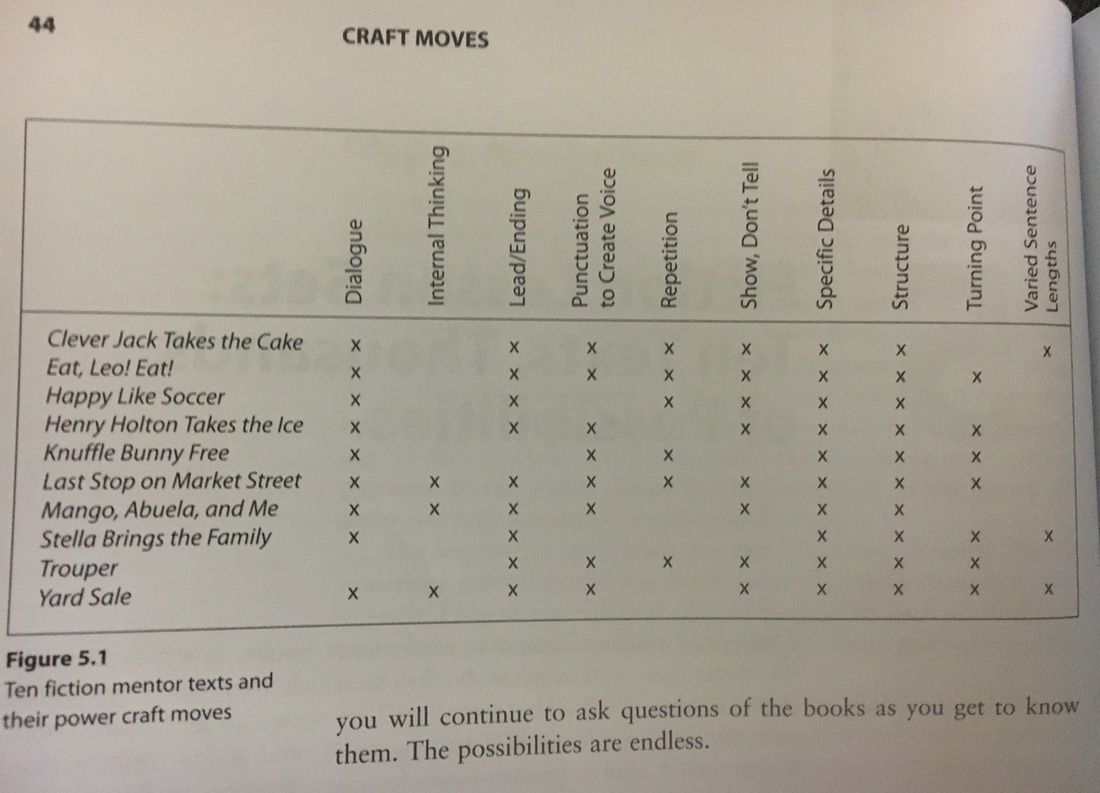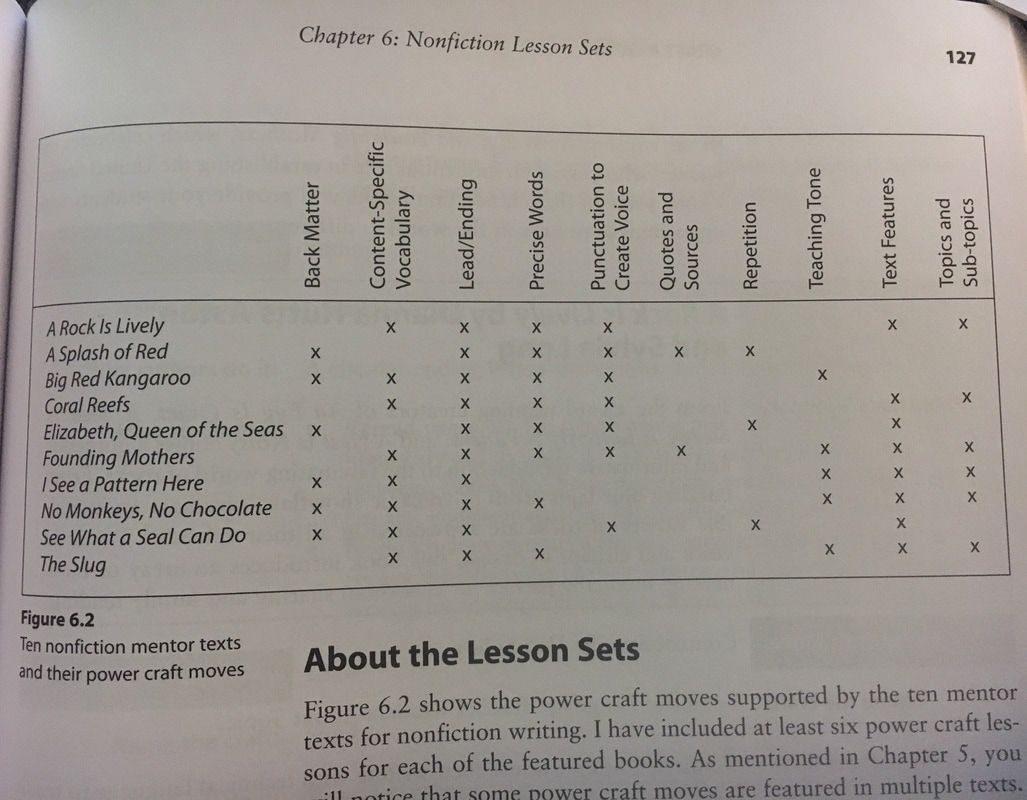But what I also found is a hidden gem of a book that I think children's writers will love. The first few chapters are really geared more toward education. However, chapters 5 and 6 are what hold valuable information. Chapter 5: Fiction Lesson Sets: Ten Texts, Thousands of Possibilities Chapter 6: Nonfiction Lesson Sets: Moving from Narrative to Informational Writing Although these are only two chapters of the book, they actually take up over half of the book. Shubitz basically takes ten recently published picture books and deconstructs them through multiple lenses. As an educator, the point is that we use picture books as our "mentor texts" to show students how the real published authors accomplish successful writing. And isn't that what we as potential children's authors do as well? (If you're smart, you do.) Take a look at all the ways she analyzes these mentor texts. These charts showcase the lessons included for each type of craft move. So if you are a writer wanting to become more effective in show don't tell, she gives you eight different lessons from eight different picture books that showcase this craft move.
If you are a nonfiction writer wanting to see how what effective leads and endings look like, she highlights ten different lessons with ten different picture books. (And actually it's twenty because leads and endings are separate.) And each type of lead and ending are different. For example a lead can open with a simile, or one that opens by developing setting, or an imagine type of lead, or a lead that opens with a letter to the reader. Each lesson follows a structure: Power Craft Move: (Such as Lead, Ending, Precise Words etc...) Name the Craft: (Such as which type of leads: Simile, Developing a Setting, Imagine) Why authors do this: (She explains the specific reason why authors would use this exact craft move.) How to do this: (This part tells you which part of the book to study so you can see how the author does this.) This section also always ends with a part called "Invite the students" and includes questions to ask the students so they can begin thinking about how they can try this craft move. For more information about Craft Moves and to preview the book online check it out at Stenhouse Publishers. https://www.stenhouse.com/content/craft-moves 2/27/2017 03:49:04 pm
Mira, Thanks so much for all the resources you offer. You are making a difference in so many lives with your teaching. Words aren't adequate to say thanks! 11/28/2021 02:27:55 am
There's a new writing app in town that can help you teach your students to write better essays with less effort on your part. Draft back allows teachers to share their rough drafts with students so they have access to the instructor's thought process during revision. This way, when it comes time for revision, all of the work is already done for both teacher and student! Read on to learn how you can use this tool in your classroom today.
Presta
9/5/2022 10:15:52 am
https://www.amazon.co.uk/Orion-Chocolate-Lick-Water-Lubricant/dp/B000FJCOOQ/ref=sr_1_4?c=ts&keywords=Lubricants+%26+Licks&qid=1660817266&s=drugstore&sr=1-4&ts_id=2758324031
Diter
9/23/2022 09:29:55 am
Cool!
alanluiz2020
10/28/2022 11:41:43 am
good 11/17/2022 03:33:54 am
Hey! I like studying, but I just do not have enough time! Luckily, I've found this writing company, and it has been a pleasure to work with on my biology assignments for the past three weeks. I finally got the best marks in this subject this term so far with support from professionals.
Jose Miller
7/14/2023 02:54:50 am
Essays play a crucial role in academic writing, allowing individuals to present and support their ideas on a particular topic. They provide an opportunity to engage in critical thinking, research, and analysis, enabling the development of strong arguments and logical reasoning. Whether it's a persuasive <a href="https://essaywriter.org/lab-report-writing-services">http://essaywriter.org/lab-report-writing-services</a> essay, an informative essay, or a narrative essay, the writing process helps to enhance communication skills and deepen understanding of the subject matter. Essays serve as a means to express thoughts, explore different perspectives, and contribute to the ongoing discourse in various fields of study.
Adell Rent
7/14/2023 02:55:17 am
https://essaywriter.org/lab-report-writing-services Comments are closed.
|
We are so excited to be mixing things up at CBA, beginning with some delicious additions to the Blogfish. Meet our awesome bloggers!!
Here's our lineup: 1st Mondays begin with former school psychologist Dr. Debra Collins who will be writing about Social emotional Learning in kidlit and behind the scenes as well as Jewish children's books. 2nd Mondays will feature super smart Melissa Stoller whose career is taking off with several new books. 3rd Mondays will feature our new blogger coming soon. 4th Mondays features new blogger, the fabulous Brentom Jackson, who has a beautiful approach to blogging. And 5th Mondays we'll be taking a break Archives
July 2024
|
|
Discover
|
About Us
|
Join Us
Join our Community and receive a fabulous free gift, KidLit tips, newsletters, scholarship info, contests, and more!
Join our KidLit Mentorship |
Social Media
Interact with our FaceBook Group or follow us on:
|
© 2010-2024 All content on this website is copyrighted. Sorry, all courses are non-refundable.



 RSS Feed
RSS Feed
